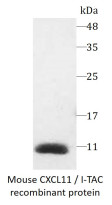ARG70443
Mouse CXCL11 / I-TAC recombinant protein (Active) (His-tagged, N-ter)
Mouse CXCL11 / I-TAC recombinant protein (Active) (His-tagged, N-ter) for SDS-PAGE
Overview
| Product Description | E. coli expressed, His-tagged (N-ter) Active Mouse CXCL11 / I-TAC recombinant protein |
|---|---|
| Tested Application | SDS-PAGE |
| Target Name | CXCL11 / I-TAC |
| Species | Mouse |
| A.A. Sequence | Phe22 - Met110 |
| Expression System | E. coli |
| Protein Full Name | C-X-C motif chemokine 11 |
| Activity | Active |
| Activity Note | Determined by its ability to chemoattract BaF3 cells transfected with human CXCR3. The ED50 for this effect is < 10 ng/mL. |
| Alternate Names | CXCL11; C-X-C Motif Chemokine Ligand 11; I-TAC; H174; IP-9; SCYB11; SCYB9B; B-R1; Small Inducible Cytokine Subfamily B (Cys-X-Cys), Member 11; Interferon-Inducible T-Cell Alpha Chemoattractant |
Properties
| Form | Powder |
|---|---|
| Purification Note | Endotoxin level is less than 0.1 EU/µg of the protein, as determined by the LAL test. |
| Purity | > 98% (by SDS-PAGE) |
| Buffer | PBS (pH 7.4) |
| Reconstitution | It is recommended to reconstitute the lyophilized protein in sterile water to a concentration not less than 200 μg/mL and incubate the stock solution for at least 20 min at room temperature to make sure the protein is dissolved completely. |
| Storage Instruction | For long term, lyophilized protein should be stored at -20°C or -80°C. After reconstitution, aliquot and store at -20°C or -80°C for up to one month. Storage in frost free freezers is not recommended. Avoid repeated freeze/thaw cycles. Suggest spin the vial prior to opening. |
| Note | For laboratory research only, not for drug, diagnostic or other use. |
Bioinformation
| Gene Symbol | CXCL11 |
|---|---|
| Gene Full Name | C-X-C Motif Chemokine Ligand 11 |
| Background | Chemokines are a group of small (approximately 8 to 14 kD), mostly basic, structurally related molecules that regulate cell trafficking of various types of leukocytes through interactions with a subset of 7-transmembrane, G protein-coupled receptors. Chemokines also play fundamental roles in the development, homeostasis, and function of the immune system, and they have effects on cells of the central nervous system as well as on endothelial cells involved in angiogenesis or angiostasis. Chemokines are divided into 2 major subfamilies, CXC and CC. This antimicrobial gene is a CXC member of the chemokine superfamily. Its encoded protein induces a chemotactic response in activated T-cells and is the dominant ligand for CXC receptor-3. The gene encoding this protein contains 4 exons and at least three polyadenylation signals which might reflect cell-specific regulation of expression. IFN-gamma is a potent inducer of transcription of this gene. Two transcript variants encoding different isoforms have been found for this gene. |
| Function | Chemotactic for interleukin-activated T-cells but not unstimulated T-cells, neutrophils or monocytes. Induces calcium release in activated T-cells. Binds to CXCR3. May play an important role in CNS diseases which involve T-cell recruitment. May play a role in skin immune responses. |
| Cellular Localization | Secreted |
| PTM | Citrullination, Disulfide bond |
Images (1) Click the Picture to Zoom In






